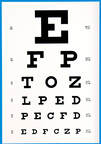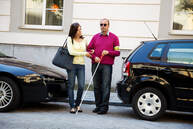
Frequently Asked Questions- and some not so frequent.

I didn't know that!

1. I've been told by Social Security that Medicare does not pay for a vision exam. Is that true?
Not true! With complicated rules back in the 60"s when Medicare was created, services were limited to "medical" services. Yet well over 90% of patients even under 65 eligible for Medicare have a medical condition diagnosed during a vision examination. Medicare is an excellent program that you and your employer paid. We accept all Medicare fees as payment in full except for a $20.00 fee not covered by Medicare in the vision examination.
Not true! With complicated rules back in the 60"s when Medicare was created, services were limited to "medical" services. Yet well over 90% of patients even under 65 eligible for Medicare have a medical condition diagnosed during a vision examination. Medicare is an excellent program that you and your employer paid. We accept all Medicare fees as payment in full except for a $20.00 fee not covered by Medicare in the vision examination.

2. What does 20/20 mean?
It is a measurement of your clarity of sight. It means what the normal person sees at 20 feet (one degree of arc), you also see at 20 feet. The top number is always the same-the standard. The bottom number is yours. The smaller the bottom number, the more clearly you see. The number 20/200 means what the normal person can see at 200 feet, you must move up to 20 feet to see the same image. The number 20/40 means what the normal person can see at 40 feet, you must move up to 20 feet to see the same image.
It is a measurement of your clarity of sight. It means what the normal person sees at 20 feet (one degree of arc), you also see at 20 feet. The top number is always the same-the standard. The bottom number is yours. The smaller the bottom number, the more clearly you see. The number 20/200 means what the normal person can see at 200 feet, you must move up to 20 feet to see the same image. The number 20/40 means what the normal person can see at 40 feet, you must move up to 20 feet to see the same image.

3. Are eye glasses addictive? I've been told, the more I wear them, the worse I'll get.
There is some truth to this. Yet, there are different kinds of glasses. Most are prescribed glasses to compensate for a defect like nearsightedness or astigmatism. Unfortunately my profession deemed them "corrective" as they "corrected" a defect. I would prefer to say they compensated for the defect and call them compensative glasses. Those glasses tend to be addictive. During the 60's a study showed that those who were prescribed compensative glasses required stronger glasses within a year (around 90%). On the other hand, Lens therapy glasses prescribed for where we want your eyes to be rather than where they are, never become addictive. Yet, often compensative glasses need to be and should be prescribed and worn for safety and comfort.
There is some truth to this. Yet, there are different kinds of glasses. Most are prescribed glasses to compensate for a defect like nearsightedness or astigmatism. Unfortunately my profession deemed them "corrective" as they "corrected" a defect. I would prefer to say they compensated for the defect and call them compensative glasses. Those glasses tend to be addictive. During the 60's a study showed that those who were prescribed compensative glasses required stronger glasses within a year (around 90%). On the other hand, Lens therapy glasses prescribed for where we want your eyes to be rather than where they are, never become addictive. Yet, often compensative glasses need to be and should be prescribed and worn for safety and comfort.

4. In people who are blind, is black all they see?
No, the majority of people can see objects, they are just not as clear as they should be. Visual acuity of 20/200 is considered blind. Some people have 20/20 visual acuity but are still blind because their side vision is reduced to less than 15 degrees. See Blake Mutschler's story.
No, the majority of people can see objects, they are just not as clear as they should be. Visual acuity of 20/200 is considered blind. Some people have 20/20 visual acuity but are still blind because their side vision is reduced to less than 15 degrees. See Blake Mutschler's story.

5. I've been told my child's nearsightedness is inherited? Is that true?
This is an age old debate, not yet fully settled. Research, tends to trend more toward the not inherited view. Look at nearsightedness in Explanations and videos about your diagnosis.
This is an age old debate, not yet fully settled. Research, tends to trend more toward the not inherited view. Look at nearsightedness in Explanations and videos about your diagnosis.

6. I've been told it is too late to treat my child’s amblyopia (lazy eye) since he is older than seven.
Not true!!!!! This is an example of old ideas dying hard. The theory is more than 200 years old. It was not true when it was imagined by leading eye doctors in arm chair discussions with no study done. In the 60's Dr. Bob Sanet, then as a student at SUNY, researched the literature and found the success rate for treating amblyopia after age seven was greater than those who were treated before age seven. Numerous studies in neuroplasticity have demonstrated the critical age of seven just isn’t true. Certainly, treat your child when the condition is found, if before seven; but it is treatable even in adulthood. Unfortunately, the majority of eye docs still believe the faulty concept.
Not true!!!!! This is an example of old ideas dying hard. The theory is more than 200 years old. It was not true when it was imagined by leading eye doctors in arm chair discussions with no study done. In the 60's Dr. Bob Sanet, then as a student at SUNY, researched the literature and found the success rate for treating amblyopia after age seven was greater than those who were treated before age seven. Numerous studies in neuroplasticity have demonstrated the critical age of seven just isn’t true. Certainly, treat your child when the condition is found, if before seven; but it is treatable even in adulthood. Unfortunately, the majority of eye docs still believe the faulty concept.

7.Does the color of my car make any difference? Is there a color I should avoid?
That is simple Black is the color to avoid. A black car blends in with the black tar roadway. Notice the next time you start to pull into the intersection and have to put on the breaks at the last moment as you did not see a car coming. I’ll bet you had to break for a black car! Some dark green and brown cars are less visible also. What do I do if I already own a black car? Always drive with your headlights on and you will be seen.
My colleagues in Canada reminded me that white may not be the best color for driving in snow!
That is simple Black is the color to avoid. A black car blends in with the black tar roadway. Notice the next time you start to pull into the intersection and have to put on the breaks at the last moment as you did not see a car coming. I’ll bet you had to break for a black car! Some dark green and brown cars are less visible also. What do I do if I already own a black car? Always drive with your headlights on and you will be seen.
My colleagues in Canada reminded me that white may not be the best color for driving in snow!

8. Does gravity have anything to do with vision?
Yes, most emphatically! Just as our blood vessels are designed to interact with gravity, so are our eyes. The valves in our blood vessels are programed for gravity. If you stand on your head the blood rushes to your head in that unusual position.
Yes, most emphatically! Just as our blood vessels are designed to interact with gravity, so are our eyes. The valves in our blood vessels are programed for gravity. If you stand on your head the blood rushes to your head in that unusual position.

Our astronauts are ill for two weeks when they return from space, but cosmonauts are not. Cosmonauts receive vision therapy before, while, and after they are in space. Our astronauts are not. There is good reason some are put in a wheel chair immediately after exiting the space capsule.

9. I heard breast feeding is good for my baby. Does that have anything have to do with mother's milk?
Breast-fed babies are more intelligent but it’s not due to mom’s milk. Certainly, mothers milk has many advantages. Now, why are breast fed babies more intelligent?
When your baby is feeding from mom’s left breast the right arm, right leg, and right ear are against mom’s chest cavity while the right eye is blocked The left arm and left leg are free to move while the right ear is listening to a familiar heart beat and the left eye is open. It is vice versa when feeding from the right breast.The baby is developing bilateral integration, an important step in intelligence.
Breast-fed babies are more intelligent but it’s not due to mom’s milk. Certainly, mothers milk has many advantages. Now, why are breast fed babies more intelligent?
When your baby is feeding from mom’s left breast the right arm, right leg, and right ear are against mom’s chest cavity while the right eye is blocked The left arm and left leg are free to move while the right ear is listening to a familiar heart beat and the left eye is open. It is vice versa when feeding from the right breast.The baby is developing bilateral integration, an important step in intelligence.

If bottle feeding be sure to switch positions half way through

10. God knew we were going to play baseball so he designed our vision to help! Pretend you are the short stop and a ground ball is hit to you. Once caught you turn your head to the first baseman. When you move your head vision information processing shuts down. That way you don't see the crowd in the stands moving in the opposite direction of your head turn so you can maintain concentration. Meanwhile auditory processing opens up and you can hear the base runner.

11. should the temples of your glasses touch your ears?
No, that would hurt. To properly customize eyeglasses for your comfort the temples should be bent so they conform to the mastoid hollow behind your ears. The mastoid hollow is an indentation behind your ears. If you reach just behind your ear you should feel the indentation. We provided comfortable well fit glasses to a patient who lacked ear lobes.
Also the temples should not touch your head until the top of your ears at the point they are bent to reach your mastoid hollow. If they touch your skull not only will they leave a line on your skin, but will slide down your nose.
No, that would hurt. To properly customize eyeglasses for your comfort the temples should be bent so they conform to the mastoid hollow behind your ears. The mastoid hollow is an indentation behind your ears. If you reach just behind your ear you should feel the indentation. We provided comfortable well fit glasses to a patient who lacked ear lobes.
Also the temples should not touch your head until the top of your ears at the point they are bent to reach your mastoid hollow. If they touch your skull not only will they leave a line on your skin, but will slide down your nose.